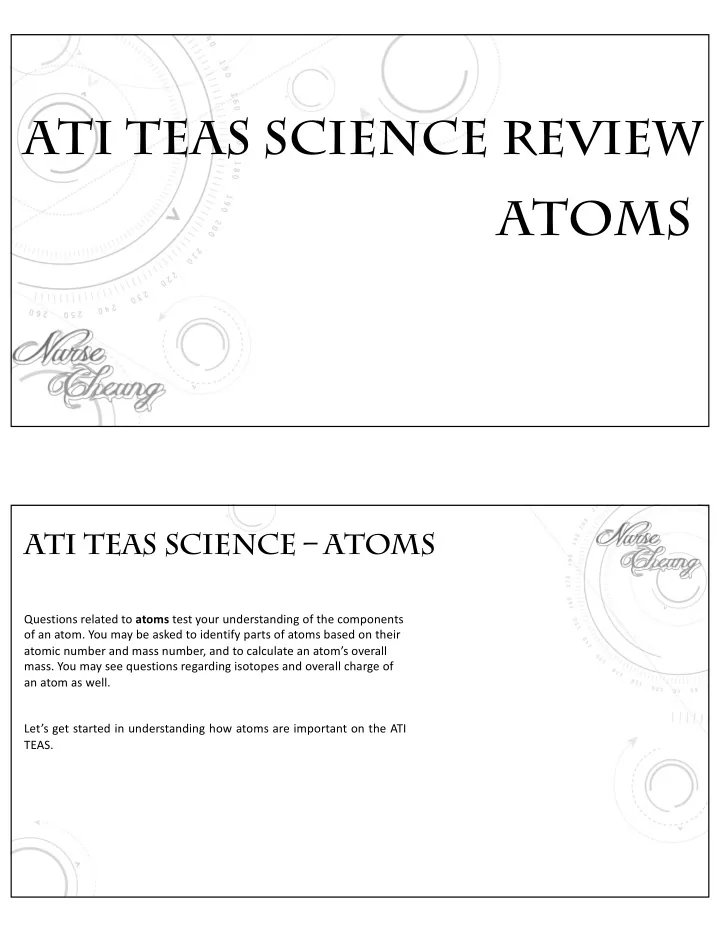

ATI TEAS SCIENCE REVIEW ATOMS ATI TEAS SCIENCE – ATOMS Questions related to atoms test your understanding of the components of an atom. You may be asked to identify parts of atoms based on their atomic number and mass number, and to calculate an atom’s overall mass. You may see questions regarding isotopes and overall charge of an atom as well. Let’s get started in understanding how atoms are important on the ATI TEAS.
ATI TEAS SCIENCE – ATOMS UNDERSTANDING ATOMIC COMPONENTS An atom is the smallest unit of an element that still possesses all of the properties of that element. Atoms contain three component parts: • Protons are positively charged particles located in the nucleus (center of the atom) • Neutrons are also located in the nucleus of the atom, but have neutral PHOTO CREDIT: AZCHEMISTRY electrical charge • Electrons are negatively charged particles that orbit around the nucleus of the atom Valence electrons are those in the outermost shell of an atom that can participate in the formation of a chemical bond with another atom. In terms of size, protons and neutrons are roughly the same size, and they are much larger than electrons. ATI TEAS SCIENCE – ATOMS UNDERSTANDING ATOMIC NUMBERS AND MASS NUMBERS The atomic number of an element is an identifying number that indicates the number of protons found in atoms of the element. An atom of an element with an atomic number of 8 would have 8 protons in its nucleus; an atom with an atomic number of 14 has 14 protons. The atomic number is equivalent to the number of protons. The mass number of an element is an identifying number that indicates the number of protons plus the number of neutrons found in atoms of that element. An atom with an atomic number of 8 and a mass number PHOTO CREDIT: SLIDE PLAYER of 17 would have 8 protons and 9 neutrons. To calculate the number of neutrons that an atom possesses, subtract the number of protons from the mass number: Mass number – number of protons = number of neutrons An atom with 12 protons and a mass number of 24 would have 24 – 12, or 12 neutrons.
ATI TEAS SCIENCE – ATOMS UNDERSTANDING ATOMIC NUMBERS AND MASS NUMBERS Protons and neutrons each have a mass of 1 atomic mass unit (AMU). To determine the approximate overall mass of an atom in AMUs, we add the number of protons and neutrons. Electrons are left out of this equation because the mass of electrons are so small relative to that of protons and neutrons. PHOTO CREDIT: SLIDE PLAYER ATI TEAS SCIENCE – ATOMS UNDERSTANDING ISOTOPES Atoms of a given element always have the same number of protons, but the number of neutrons may vary. One atom of nitrogen may have 7 protons and 7 neutrons, while another atom may have 7 protons and 8 neutrons. These different versions of atoms are called isotopes . In the nitrogen example given, the first isotope would be referred to as nitrogen-14 or N-14. The second isotope, with a mass number of 15, would be referred to as nitrogen-15 or N-15. PHOTO CREDIT: TIME SCAVENGERS
ATI TEAS SCIENCE – ATOMS UNDERSTANDING ATOMIC CHARGE/IONS The charge of an atom can be either positive, negative, or neutral. The atomic charge is affected by the numbers of protons and electrons in the atom; neutrons do not affect the charge, as they have no charge themselves. A neutral atom has the same number of protons and electrons. The protons are positively charged, and the electrons are negatively charged, so when they are present in equal numbers, they balance each other out. PHOTO CREDIT: THOUGHT CO An atom can give off or gain electrons, which causes its charge to shift from neutral to positive or negative. An atom that has an electrical charge is known as an ion . If an atom gives off electrons, it will have fewer electrons than protons, and its charge will be positive ( cation ). If an atom gains electrons, it will have more electrons than protons, so its charge will be negative ( anion ). ATI TEAS SCIENCE – ATOMS UNDERSTANDING ATOMIC CHARGE/IONS A neutral isotope of nitrogen-14 would have 7 protons, 7 neutrons, and 7 electrons. The atomic number of nitrogen is 7, so we know that it has 7 protons, and the mass number of the nitrogen-14 isotope is 14. This means the number of neutrons is 14-7, or 7. The isotope is neutral, so it must have the same number of electrons as protons. PHOTO CREDIT: THE ATOMIC PROJECT A negatively charged isotope of nitrogen-14 would have more electrons than protons. If the charge was -1, the isotope would have 7 protons, 7 neutrons, and 8 electrons. The -1 charge tells us that this isotope contains 1 more electron than the number of protons. In shorthand, this -1 charge would be written as N-. An ion with a positive charge of +1 would be written as N+.
ATI TEAS SCIENCE – ATOMS UNDERSTANDING ATOMIC CHARGE/IONS Atoms are stable when they have full valence shells (like the noble gases do). They gain or lose electrons, forming ions, in pursuit of that stability. Bonds that form between oppositely charged atoms via the transferring of electrons are ionic bonds . Compounds that have ionic bonds can conduct electricity and are water soluble. Bonds that form between atoms via the sharing of electrons are covalent bonds . Bonds with partially covalent and partially ionic characteristics are polar covalent bonds . PHOTO CREDIT: QUORA PHOTO CREDIT: BRITANNICA
Recommend
More recommend